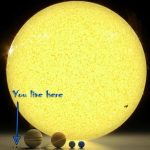Key Takeaways
- The Crescent Nebula, also known as Caldwell 27 and NGC 6888, is an emission nebula located in the constellation Cygnus, approximately 5,000 light years away from Earth.
- It is energized by the strong stellar wind from the Wolf-Rayet star WR 136 at its center, and its shape resembles that of a crescent or the Euro sign.
- The nebula was formed around 250,000 to 400,000 years ago when the fast stellar wind from WR 136 collided with the slower-moving wind ejected by the star during its red giant phase.
- The nebula’s low surface brightness requires dark skies and a UHC or OIII filter to be visible in smaller telescopes, while larger instruments reveal its crescent shape.
- The star WR 136 is expected to end its life in a supernova explosion in a few thousand years and is significantly larger, more massive, and more luminous than the Sun.
The Crescent Nebula, commonly known as Caldwell 27 or NGC 6888, captivates astronomers and stargazers alike with its striking resemblance to a prehistoric dinosaur egg. Situated in the Cygnus constellation, approximately 5,000 light years from Earth, this emission nebula is energized by the powerful stellar wind emitted from the Wolf-Rayet star WR 136, positioned at its core.
Despite its apparent size of 18′ × 12′, the Crescent Nebula is relatively faint, necessitating dark skies and specialized filters for optimal observation. In telescopes with at least an 8-inch aperture, its unique crescent shape becomes evident, making it a noteworthy celestial object in the dense field of the Milky Way.
Designated by various names such as NGC 6888, Sharpless 105, and Caldwell 27, this enigmatic nebula’s origins can be traced back to a collision event. The Wolf-Rayet star WR 136 collided with the slower-moving wind ejected during its red giant phase, resulting in the formation of a dense shell and two shock waves. These shock waves produce the nebula’s striking green filamentary structure and a heated bubble of gas emitting X-rays.
William Herschel’s discovery of the Crescent Nebula in 1792 marked the beginning of its study and fascination among astronomers. With its impending supernova explosion and intriguing characteristics, this celestial wonder continues to unveil its secrets, inviting further exploration and wonderment.
Read full article on The Planets
#1

NGC 6888 in bicolor Ha/OIII from amateur equipment. Via Hewholoooks
#2

Credit: AstroBackyard
#3

The Crescent Nebula captured using a color camera through a refractor telescope.
#4

Image Credit & Copyright: Joe Navara, Glenn Clouder, Russell Discombe
#5

Copyright © Aleix Roig Mateu
#6

Credit: ESA/XMM-Newton, J. Toalá & D. Goldman
#7

Crescent Nebula in Cygnus; 500 mm Cassegrain 3625 mm f/7.2; SBIG STL11K; 280+120+120+120 min LRGB; Bernese Highlands; © 2017 Radek Chromik
#8

Credit: X-ray: NASA/UIUC/Y. Chu & R. Gruendl et al. Optical: SDSU/MLO/Y. Chu et al.


